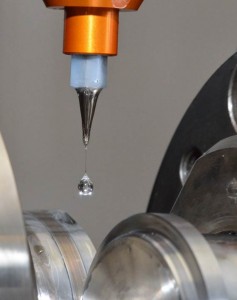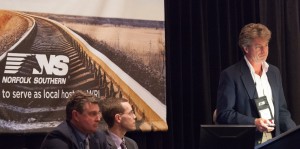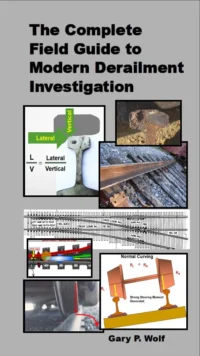WRI 2015 — Heavy Haul Part 1: Interface Management From Micro to Macro
By Jeff Tuzik
Proper management of the wheel/rail interface is a daunting process. It involves elements of design and planning, automated and manned inspection, corrective and preventive maintenance and data management, to name only a few. Managing the systemic health of a railroad means understanding processes that range from the microscopic details of rail contact fatigue, to the components of truck design, and the invisible flow of data. Part 1 of the Heavy Haul coverage of WRI 2015 takes all these elements and more into account in an effort to better illuminate the systemic nature of wheel/rail interaction.
Derailments, the most catastrophic events that can occur on a railroad, highlight the interplay of all the parts of the wheel/rail, vehicle/track system (see: Effects of Wide Gauge). Among derailment causes, wide-gauge derailments, often rail rollover events, represent the most-used cause code in the FRA database of accidents. However many of these derailments are attributed to wide gauge even when the origins of the failure may lie elsewhere, or in some combination of factors, said Gary Wolf, President of Wolf Railway Consulting LLC.
“It’s a systems problem. Gage can widen because of rail translation or rollover for a number of reasons. There are a lot of factors at play,” he said.
Those factors include:
- Incorrect curve elevation
- Pre-existing wide gauge allowing for increased forces
- Horizontal alignment kinks in curves
- Lack of top of rail (TOR) friction modifiers and/or gauge-face lubrication
- Poor steering due to wheel/rail profile
- Compressive buff forces
- Mechanical factors such as warped or poorly-steering trucks
Since so many different factors can contribute to a wide-gauge/rail rollover derailment, it’s important to address the matter with a systems-minded approach. From a design and maintenance perspective this means choosing (and maintaining) proper superelevation so that vertical loads are balance between the high and low rails. Railroads typically under-elevate to allow for trains operating at lower speeds in curves, Wolf said, but this increases vertical forces on the low rail and contributes to gauge widening.
Alignment kinks, such as can be introduced by a plug rail, can also contribute to gauge widening by creating a “flat spot” in a curve and causing adverse flanging forces. Flanging and lateral forces are also strongly, positively, affected by TOR friction modifiers and gauge-face lubrication. “The science is there,” Wolf said, “even moderate lubrication can have a significant positive effect on L/Vs.”

The degradation of rail fasteners is another contributor to rail translation and rollover. The presence of raised spikes in a curve, for example, is a clear indication that the rail is trying to roll (see Controlling Rail Cant). Similarly, rail seat abrasion on concrete ties leads to the loss of lateral and longitudinal rail restraint, causing the rail to cant outward toward the abraded rail seat. Because forces imparted to the rail are transmitted into the ties and fasteners, the use of friction modifiers and lubrication is an important part of tie and fastener maintenance, as well, added Norm Hooper, Principal of Hooper Engineering.
There are also practices on the Operations and Mechanical side of the system that can decrease forces that can lead to a wide-gauge derailment. Dynamic or engine braking, for example tends to push cars outward in a curve, putting excessive pressure on the gauge restraint of the curve.
Stiff truck conditions can cause negative steering moments, and warped trucks generate excessive angles of attack and creep forces, leading to gauge-spreading forces on both the high and low rails, Wolf said.
The truck itself is a complex system whose proper function depends on the smooth interaction of many variables and components.
“The bolster bowl liner is a relatively simple part. But it affects everything the truck does,” said John Jeambey, Director of Research and Development at TTX Company.
TTX recently tested a series of bolster bowl cup liner configurations at the Transportation Technology Center Inc. (TTCI) test track in Pueblo, Colo. Part of the impetus for the study was the fact that TTX’s Reasearch and Development group couldn’t tell the difference between manganese steel and non-metallic cup liners based on truck performance detector (TPD) data, which raised the question of how much variation in truck performance could actually be attributed to the cup liner type.
“Configuring a three-piece truck is always a compromise between high-speed stability and curve performance,” Jeambey said. So, the primary focus of the study was to measure the curving performance and high-speed stability of different liner configurations: non-metallic versus manganese steel.
The tests focused on truck performance on fully-loaded (157,000-lb) cars running at underbalance speed. “That’s the worst thing you can do to a truck,” Jeambey said. Early testing showed that the two liner materials (manganese and non-metallic) had very similar torque values on the bolster and similar TPD results. There were, however, measurable differences. The manganese cup liners for example, generated on average 6.6% higher L/Vs. The non-metallic cup liners on the other hand had a 15.6% higher average hunting index. More significantly, the non-metallic liners also lost 46% more material due to wear than the manganese liners.
As with other aspects of three-piece truck design, the liner types present a trade-off. There was a slight advantage in curving for non-metallic bolster bowl liners and a slight advantage in hunting resistance for manganese liners. In this case, the deciding factor between the cup liners may lie in the different wear rates, rather than in curving and hunting performance, Jeambey said.
TOR Friction Modifiers

As Gary Wolf noted, the forces present at the wheel/rail interface during curving are strongly affected by the coefficient of friction (COF) at the top of rail and gauge face.
Lubrication and friction modifiers developed to control the COF have become a critical part of the wheel/rail system, and although their use is well established and proven-effective, there is a significant amount of ongoing research in the field.
In an effort to improve the efficiency and carry rate of top of rail (TOR) friction modifiers, some companies have developed synthetic or oil-based products. These products and their performance are often compared to the somewhat older and more established water-based TOR friction modifiers.
A previous study conducted at Sheffield University’s SUROS twin-disc machine evaluated and compared synthetic and water-based TOR products based on the development of rolling contact fatigue (RCF). This initial study seemed to indicate that synthetic-based TOR products tended to induce RCF damage and crack growth at a faster rate than their water-based counterpart.
But TOR is only part of rail management. Rail grinding to remove RCF damage also plays a significant role.
Expanding on the Sheffield study, Nicholas Dryer, Manager of Roadway Planning, Rail Friction Management at BNSF, and Mark Richards, Research Metallurgist at EVRAZ North America, conducted a follow-up study, again comparing synthetic and water-based TOR products, but this time with the inclusion of a simulated rail grinding cycle. Like the previous study, rail surface damage was monitored in situ via eddy current, and using an electron microscope for confirmation.
The first step of the study was to induce crack initiation by running the discs without any TOR product for 4,000 cycles. “In the first round of testing, we applied TOR from the beginning and found we could essentially go on forever without inducing RCF,” Dryer said. “We found that initial dry cycles are needed to really initiate cracking. ”
Post TOR cycle analysis turned up some interesting results; the water-based TOR disc lost nearly double the mass of the synthetic-based TOR disc, but the synthetic TOR sample exhibited greater crack length increase. “This may be a manifestation of controlled surface wear [of water-based TOR] actually reducing crack growth,” Dryer said.
The synthetic- and water-based TOR discs displayed similar surface damage when viewed under an electron microscope, indicating that despite the difference in crack growth rate, the wear mechanism in both cases appeared to be same.
Phase 2 of the study began with simulated grind cycles, which were developed to remove an amount of material from each disk such that all but 1% of cracks were removed. This meant grinding away 220 micrometers of material from the synthetic TOR sample, and 100 micrometers from the water-based TOR sample. After grinding, the samples were put through an additional 210,000 cycles of testing, again with continuous TOR product application.

Based on eddy-current readings (and microscope verification) the water-based TOR sample showed very little perceptible crack growth during the post-grind testing: a total of 33 flaws with a maximum depth of 20 microns. The synthetic-based TOR sample showed a jump in crack growth (up to 0.6 mm) early in the test, then held steady for the remainder, yielding a total of 110 flaws with a maximum depth of 1 mm.
Dryer noted that synthetic- and water-based TOR materials have been in the field for a long time, and that the high level of damage seen in the synthetic-based TOR disc-on-disc test has not manifested in the field. “We believe one major factor in this study is that we may have been applying TOR material at a greater rate than you would encounter in the field,” he said.
Still, there are some clear takeaways from the test. First, that dry cycles will very quickly initiate surface damage and RCF cracking, so it’s important to keep TOR applicators in service at all times. And second, that rail grinding to eliminate RCF, combined with TOR FM use, significantly reduces the rate of crack propagation.
Friction management is only one piece of a very large mechanism. But like most aspects of the wheel/rail interface it has systemic influence.
Switch Point Inspection
Switch point derailments tend not to be as catastrophic as wide gauge derailments since they tend to occur in yards and on industrial tracks, where speeds are low and damage does not reach the FRA-reportable threshold. But that doesn’t mean they’re a minor problem. According to Brad Kerchof, Director of Research and Tests at Norfolk Southern, industry-wide switch point derailments (including reportable and non-reportable incidents) likely exceed 1000 a year.
Part of the difficulty of assessing switch point health and derailment potential has historically been the lack of specific tolerances and thresholds to measure to, and in fact, a lack of specific tools and gauges to take measurements in the first place.
The FRA Track Safety Standards concerning switch points states: Unusually chipped or worn switch points shall be repaired or replaced. Metal flow shall be removed to insure proper closure.
“But, what is unusually worn or broken to one inspector may be entirely different to another inspector,” Kerchof said. “It likely depends on the derailment experience that these inspectors have.”
Seeing an opportunity for the industry to improve its switch point inspection practices, particularly in the use of gauges to evaluate switch point condition, Dr. Allan Zarembski, Director of Railroad Engineering and Safety at the University of Delaware, submitted a proposal to the Transportation Research Board in 2012 to develop a set of safe/unsafe switch point safety threshold gauges. The project began soon thereafter in collaboration Norfolk Southern.
The first step in developing the gauges was to determine the specific conditions that tend to cause derailments in the first place. There are three conditions present in most wheel climb derailments, Kerchof said:
- A gapped, worn or broken switch point
- A worn wheel profile (particularly a worn flange with a sharp edge on the flange tip)
- Tracking position – the worn wheel is shifted toward the switch point
With this in mind, the next step of the project was fabricating and testing the relevant gauges. This was an iterative process that required modifying, testing and modifying again until three gauges were determined to be the most accurate and most useful:
- Worn wheel gauge with a 70-degree flange angle gauge that simulates a worn wheel flange. If the gauge catches on the top of the switch point when slid off of the stock rail, the switch point is considered unsafe.
- Worn/damaged switch point gauge. This gauge checks whether the switch point is worn or broken below a threshold height
- New wheel gauge with 60-degree contact mark. This gauge is based on an AAR 1B wheel. If a flange point contacts the gauge below the 60-degree mark, the switch point is considered unsafe.
The next phase of the project, which is currently underway, involves revenue service testing and validation of the gauges as well as collecting industry feedback on their usability and efficacy. The use of these gauges will ideally take some of the subjectivity and guesswork out of determining switch point condition. They can also help train new track inspectors. “I envision these gauges being used by a track inspector until he gains an understanding of which switch point conditions represent higher risk,” Zarembski said. “With a little practice, the inspector should be able to look at a switch point and imagine what the gauges would indicate.”
Track Buckles and Slow Orders
Track buckles, or sunkinks, are another area in which there is potential to remove some of the subjectivity from how they are monitored. Track buckles are one of the most common track defect codes in FRA accident data. They’re also the most expensive, averaging $1 million per derailment in 2012, said Andrew Kish, President of Kandrew Inc. Consulting Services.
Track buckles are generally managed and mitigated by:
- Controlling rail neutral temperature (RNT)
- Maintaining alignment and ballast condition
- Controlling train dynamics via Hot Weather Speed Restrictions (HWSRs), for example
“Current HWSRs are not based on science but on “good-feel” tradition,” Kish said. As a result, HWSRs tend to be conservative, sometimes highly so. Improving the science behind HWSRs could promote higher capacity, higher velocity, and thus higher revenue all without compromising safety, he said.
System wide slow orders typically go into effect when ambient temperatures are forecast to reach or exceed a predetermined threshold. These values may be conservative by as much as 30 degrees Fahrenheit, Kish said. A new formula based on the current understanding of rail neutral temperature (RNT) and track buckling strength may more accurately measure buckling risk and result in lower thresholds.
The new formula takes into account three primary variables: the track buckling margin of safety, track buckling strength, and rail neutral temperature. The buckling margin of safety is essentially the minimum level of acceptable safety, which is a function of track buckle probability and its relationship to high temperatures. Track buckling strength is determined by dividing track into 3 classes (weak/average/strong) and assigns each class a corresponding number (60/80/100). This number is then added to the estimated or calculated RNT. The resulting figure is the track buckling strength.
A recent case study performed on “strong” class track used rail stress modules (RSMs) to determine RNT. Based on the RNT, the “strong” class modifier, and the rail operator-defined buckling margin of safety, the new formula found an acceptable/safe slow order temperature of 163-degrees on the high rail, and 135-degrees on the low rail. Prior to the study, the rail was under an HWSR of 90-degrees ambient.
Overly conservative slow orders like the above are unnecessary from a safety standpoint, Kish said. And case studies such as the 2009 Amtrak/AREMA Torsino/Chismer Study, have indicated a very small increase in slow order temperatures results in a large positive impact on overall system velocity and thus operational efficiency.
It’s easy to get overwhelmed by the subsystems that make up the overall system of wheel/rail interaction. It’s something of an analogue problem that now has a growing digital equivalent. Because it’s also easy to get overwhelmed by the amount of data now collected by systems deployed across railroads and throughout the industry.
Big Data
Big data may have become a buzzword in the past few years, but the issues associated with it are real. The railroad industry is just one of many industries now wrestling with big data. “We’re looking at 100 gigabytes a day from one track inspection vehicle,” said Larry Biess, Director of Business Intelligence, CSX Transportation. With dozens of vehicles operating on each property every day, it’s easy to see why big data is a hot topic.
Track inspection makes up a large part of big data, largely due to the increased use of automated inspection technologies. Even excluding track inspection vehicle data, one wayside detector can measure roughly three million wheels a year; one railroad can, conservatively, record 70,000 exceptions and 20,000 rail defects per year.
“If you get overwhelmed with exception data, then you’re just fighting fires. You’re not thinking proactively,” said Kevin Day, Assistant Chief Engineer, Technology, Testing, and Standards at Canadian National Railway.

These detector and inspection technologies have been invaluable, and provide tremendous amounts of useful data. But there’s a difference between data and information. “We don’t need data to manage our business. We need information,” said Zarembski, who moderated the panel on Big Data (Zarembski also previously hosted a conference on the topic at the University of Delaware — see: Big Challenges, Big Opportunities). “We need to extract information from the data.”
Threshold analysis is one of the simplest applications of collected data, but it’s also one of the shallowest applications that doesn’t necessarily take full advantage of the information in the data. Big data — data already collected — has the potential to be leveraged to do much more – things like trending and statistical analysis to find “hidden” relationships in the data. Predictive analytics also allows for more targeted maintenance.
And all this data can be combined with long-term planning and economic decision-making for further benefit. “If you can accurately trend the lifecycle of an asset, you can extend the life of that asset. You don’t have to worry about leaving money on the table due to premature replacement,” Biess said.
Data itself is an asset, too. But it’s an asset that the industry (every industry) is struggling to maximize – it’s money left on the table. “A lot of railroads are collecting so much data they can’t even store it all,” Zarembski said. This highlights the need for a scalable and integrated data architecture.
Developing an integrated database can be difficult for both structural and cultural reasons. Structurally, the size of the data is a clear issue, but so is transmitting and correlating it. Some data is streamed from collection points in real time, while other data may be transmitted at longer intervals or stored on distant physical media. This makes matching and collating the data more difficult than it already is. As for the cultural roadblocks, it’s not uncommon for independent databases to be maintained by isolated operational siloes. “Our industry’s data has been siloed for a very long time,” Biess said, “the current situation is unacceptable.”
Rail grinding is one example area in which a tremendous amount of data is currently being collected and leveraged in order to improve the grinding process. A grinding operation typically collects data via pre-grind inspection, via on-board monitoring during grinding, and again during post-grind inspection. “We generate roughly 5 petabytes of data per year, per railroad related to grinding,” said Joe Palese, Sr. Director of Engineering at Harsco Rail.
The trick, then, is to turn that big data into small information that can in turn be used to make informed decisions. This can be a balancing act of reducing the resolution of the data without reducing its accuracy. “We take 500 X/Y coordinates per rail profile and turn that into three figures,” Palese said.
Advanced algorithms like Markov chain Monte Carlo simulations and Bayesian inference methods are finding their way into the industry — employed to turn that profile data into information. “We’ve used these data techniques to improve grind accuracy, pattern prediction and overall performance optimization,” Palese said.
“You need simple, actionable information for resource allocation,” said Kevin Day.

Simplification, or data-to-decisions, is a constant theme, and one of the near-term goals when it comes to big data. Railroads have had a long time to learn how to react quickly to exception data, but the number of systems looking for exceptions and their constantly improving accuracy has exacerbated the “firefighting” mentality in some cases.
So another part of the simplification effort is in developing understandable and actionable track health and condition metrics that are made of many data points from different systems and different points in time, for example.
CN, for example, like many railroads has a large historical database full of track defect information. Databases like that can be a trove of useful information with the application of the right algorithms. It can be leveraged to find clusters of defects and identify trends in defect growth, for example, and it’s a process that doesn’t require the collection of additional data, Day said.
Managing and maintaining the wheel/rail interface, like managing any aspect of a railroad is a task that can quickly become overwhelmingly complex. From the micro- to the macroscopic every variable, every component of the track or vehicle is itself a collection of interconnected variables. As the industry-wide understanding of the principles of wheel/rail interaction deepens, it increases in complexity. Fortunately, advances in technology and data-management techniques allow the industry to take advantage of new data rather than drowning in it. And discussions like those at WRI help, not just to disseminate information, but to break down siloes and turn data into practical information.
In addition to the upcoming WRI 2016 in Las Vegas, Wheel Rail Seminars will be hosting the first annual WRI European Union conference in Derby, England. The conference will focus on wheel/rail interaction from the EU perspective and IJ will be there to report on the tools, techniques, and challenges faced by transit properties on the other side of the Atlantic.

Jeff Tuzik is Managing Editor of Interface Journal


